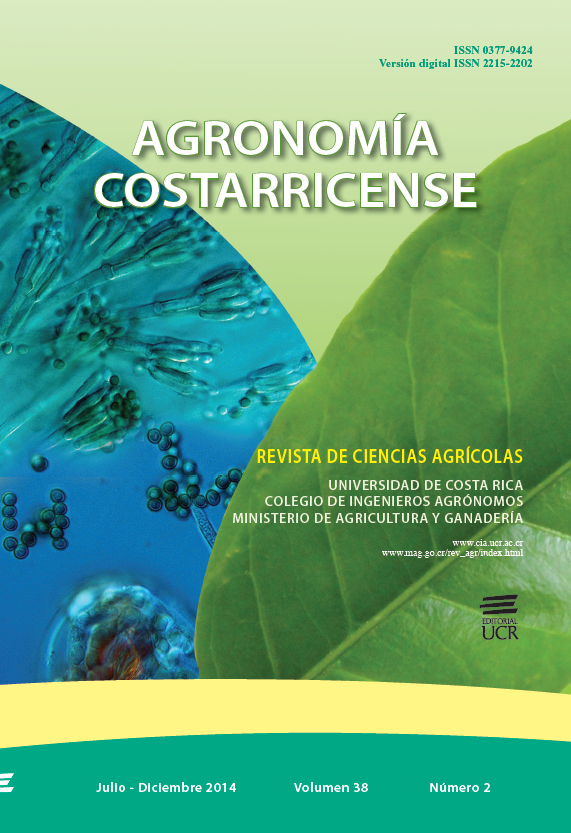Abstract
Clinical hypo-calcemia (CH) is a common metabolic disease in cows grazing lush pastures high in potassium. The aim of this study was to determine the prevalence of CH and subclinical hypocalcemia (SH) in 4 grazing Jersey herds in Costa Rica. Subclinical hypocalcemia has been studied to a limited extent in tropical dairy systems. Two hundred and seven Jersey cows from 4 herds located in the highlands of Cartago, Costa Rica, were used to analyze serum calcium (Ca) contents. Feeding practices during the close up period were based on intensive grazing of kikuyu grass (Kikuyuocloa clandestina) and the supplementation of 3 to 4 kilograms of a grain mixture low in Ca (0.2% of dry matter). Blood samples were arranged by lactation number: 1st (n=36), 2nd (n=48), 3rd (n=49), 4th (n=41), 5th (n=17) and 6th (n=16). Average serum Ca concentration within the criti- cal period for hypocalcemia incidence (24 h befo- re or after parturition) decreased with lactation number. Incidence of CH was 6, 13, 2, 29, 29 and 25% of cows from 1st to 6th parity, respectively. Likewise, average prevalence of SH was 53, 42, 78, 44, 47 and 63%, in the same order. Cows with a body condition score (BCS) of 3.75 or higher at parturition ± 1 week had lower (p<0.05) serum Ca concentration than those with lower BCS. Serum magnesium contents were normal. These results show that prevalence of SH is greater than 40% in Jersey herds grazing lush tropical pastures; also, data suggest that BCS during the transition period could influence serum Ca contents. However, more research should be done to support these findings.References
AUSTRALIA, STATE GOVERNMENT OF VICTORIA. DEPARTMENT OF ENVIONMENTAL AND PRIMARY INDUSTRIES. AGRICULTURE AND FOOD. 2007. Milk fever (Hypercalcemia) in cows. Consultado 30 de diciembre de 2013. Disponible en http://www.depi.vic.gov.au/agriculture-and-food/ pests-diseases-and-weeds/animal-diseases/beef- and-dairy-cows/milk-fever-hypocalcaemia-in-cows
CURTIS C.R., ERB H.N., SNIFFEN C.J., SMITH R. D., kronfeld d.s. 1985. Path analysis of dry period nutrition, postpartum metabolic and reproductive disorders, and mastitis in Holstein cows. J. Dairy Sci. 68:2347-2360.
CURTIS C.R., ERB H.N., SNIFFEN C.J., SMITH R.D., POWERS P.A., SMITH M.C., WHITE M.E., HILMAN R.B., PEARSON E.J. 1983. Association of parturient hypocalcemia with eight periparturient disorders in Holstein cows. JAVMA 183:559-591.
FERGUSON J.P., GALLIGAN d.t., THOMSEN n. 1994. Principal descriptors of body condition score in Holstein cows. J. Dairy Sci. 77:2695-2703.
Goff J.P. 2006. Macromineral physiology and application to the feeding of the dairy cow for prevention of milk fever and other periparturient mineral disorders. Animal Feed Science and Technology 126:237-257.
Goff J.P. 2008. The monitoring prevention and treatment of milk fever and subclinical hypocalcemia in dairy cows. Vet. J. 176:50-57.
Goff J.P., Horst R.L. 1997. Physiological changes at parturition and their relationship to metabolic disorders. J. Dairy Sci. 80:1260-1268.
Goff J.P., REINHARDT T., Horst R.L. 1995. Milk fever and dietary cation-anion balance effects on concentration of vitamin D receptor in tissue of periparturient dairy cows. J. Dairy Sci. 78:2388-2394.
Goff J.P., Sánchez J.M., Horst R.L. 2005. Hypocalcemia biological effects and strategies for prevention. Mineral Nutrition Conference. University of Tennessee. USA. 6 p.
Guard C. 1996. Fresh cow problems are costly: culling hurts the most. Proc. 1994 Annu. Conf. Vet. Cornell Univ. Ithaca, NY.100 p.
Horst R.L. 1984. Regulation of calcium and phosphorus homeostasis in the dairy cow. J. Dairy Sci. 69:604-616.
Horst R.L., Goff J.P., Reinhardt T.A. 1990. Advancing age results in reduction of intestinal and bone 1,25 dihydroxyvitamin D receptor. Endocrinology 126:1053-1067.
Horst R.L., Goff J.P., Reinhardt T.A. 1994. Calcium and vitamin D metabolism in the dairy cow. J. Dairy Sci. 77:1936-1951.
Horst R.L., Goff J.P., Reinhardt T.A., Buxton D.R. 1997. Strategies for preventing milk fever in dairy cattle. J. Dairy Sci. 80:1269-1280.
Kimura K., Reinhardt T.A., Goff J.P. 2006. Parturition and hypocalcemia blunts calcium signals in immune cells of dairy cattle. J. of Dairy Sci.
:2588-2595. national research council. 2001. Nutrient Requirements of Dairy Cattle. 7 th rev. ed. National Academy Press Washington, D.C. 381 p.
Reinhardt T.A., Lipolis J.D., Mc.Cluskey B.J., Goff J.P., Horst R.L. 2011. Prevalence of subclinical hypocalcemia in dairy herds. The Veterinary Journal 188:122-124.
Roche J.R. 2003. The incidence and control of hypocalcemia in pasture-based systems. Acta Vet. Scand. Suppl. 97:141-144.
Roche J.R., Berry D.P. 2006. Periparturient climatic, animal, and management factors influencing the incidence of milk fever in grazing systems. J. Dairy Sci. 89:2775-2783.
SÁNCHEZ J.M., GOFF J.P. 2006. Strategies for controlling hypocalcemia in dairy cows in confinement and pastures, pp. 182-187. In: Production diseases in farm animals. Edited by N. Joshi and T.H. Herdt. Wageningen Academic Publishers. Wageningen, The Netherlands.
VAN DE BRAAK A.E., VAN’T KLOOSTER A.T., MALESTEIN A. 1987. Influence of a deficient supply of magnesium during the dry period on the rate of calcium mobilization by dairy cows at parturition. Res. Vet. Sci. 42:101-108.
ZETTNER A., SELIGSON. D. 1964. Application of atomic absorption spectrophotometry in the determination of calcium in serum. Atomic Absorption Spectrophotometry 10(2):869-890.


